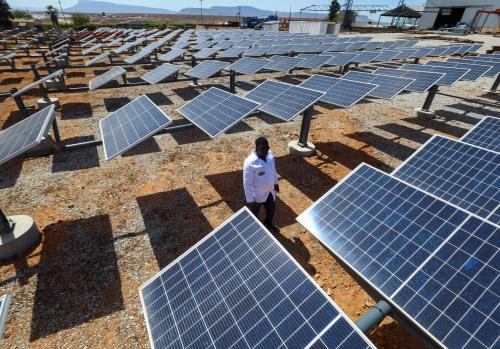Executive summary
This report examines the potential for industries without smokestacks (IWOSS) in creating large-scale job opportunities in Nigeria, particularly for the young and female population subgroups. With the emergence of technology and shifts in the global economy, the relevance of some industries in economic development have increased. These industries are codified as IWOSS. IWOSS are sectors with higher labor productivity relative to traditional agriculture, and they are also tradable (Bhorat et al. 2020; Heitzig et al. forthcoming). These sectors include agro-processing, financial and business services, information and communications technology (ICT), tourism, formal trade, and transport. The emerging role of IWOSS is particularly important as evidence indicates that the employment crisis and poor performance of manufacturing have become major concerns in Nigeria.
The study addresses the following questions: (i) What is the employment situation in Nigeria? (ii) What is the pattern of sector growth vis-a-vis performance of IWOSS and non-IWOSS sectors in Nigeria? (iii) What is the potential growth and labor demand of IWOSS sectors? The methods employed include an evaluation of sectors’ performance in terms of growth and wage employment, analyses of present and future levels of employment and productivity, and the use of a value-chain approach to assess employment creation potential and significant constraints. These approaches are complemented with a survey conducted between February and September of 2022 with firms selected from three IWOSS sectors.
The selected sectors for in-depth evaluations were financial and business services, ICT, and formal trade. The sectors were selected due to their relatively high productivity and positive employment elasticities. Baccini et al. (2021) noted that sectors with higher labor productivity drive economic development in 13 African countries, including Nigeria. For Nigeria to achieve sustained economic growth with significant job creation opportunities, sectors with high labor productivity need to be prioritized.
This study’s findings show that the relatively high growth the Nigerian economy experienced during the 2000s has become fragile in the last few years. As a result, the number of jobs created was below the number of people entering the labor market, leading to a rising unemployment rate, especially among youths. Nevertheless, the service sector—comprising mostly IWOSS sectors—contributed the majority of total output (50 percent) and employment (53 percent), as of 2019. Accordingly, IWOSS such as construction and ICT have increased their contribution to output by an average of 74 percentage points while others, such as the mining sector, have drastically declined by up to 61 percentage points between 2000 and 2020. On employment, IWOSS sectors such as financial and business services and trade have increasingly contributed to employment between 2010 and 2018. Consequently, there is a labor resource shift from low-productivity sectors such as traditional agriculture to higher-productivity sectors such as the financial and business services sector.
Further, the study finds that IWOSS sectors contracted during the COVID-19-induced recession; however, the IWOSS sectors’ rate of recovery was higher than that of the manufacturing and non-IWOSS sectors. This suggests that IWOSS sectors are more resilient, contributed significantly to the rapid recovery of the Nigerian economy, and will continue to play an important role in the post-pandemic era. Even during the peak of the pandemic, the ICT sector (an IWOSS sector) experienced a positive growth of about 15 percent, which was due to an increased digitalization of economic activities. Other IWOSS sectors were fully recovered by the first quarter of 2022.
The analysis also shows youths and females make up a higher percentage of the demographic in jobs in the IWOSS sectors than they do in the non-IWOSS sectors. In 2018, for example, women represented 34 percent of employment in IWOSS sectors compared to 32.2 percent for non-IWOSS sectors. Additionally, the share of 25-34-year-olds in total employment was higher for IWOSS sectors (29.8 percent) compared to non-IWOSS sectors (26.3 percent). This suggests that IWOSS sectors are more inclined toward employing youths compared to non-IWOSS sectors in Nigeria.
However, most of those employed in IWOSS sectors have relatively higher education. Specifically, in 2018, 76.7 percent of the total labor force in IWOSS sectors had secondary and post-secondary education compared to 57.4 percent in non-IWOSS sectors. The IWOSS sectors that accounted for the most employment of highly skilled workers were formal trade and financial and business services, while the sector that accounted for most of the employment of the low-skilled workforce was the export crops and horticulture sector.
In the future, IWOSS sectors are projected to deliver the majority of jobs to labor market entrants. The study estimates that IWOSS sectors could create up to 56 percent of the projected 47.3 million new jobs between 2018 and 2035; however, fewer jobs will be created for unskilled workers. Of the 47 million new jobs, IWOSS sectors will generate 27 million, out of which 9 million jobs will employ females.
The report further highlights the general and sector-specific constraints limiting the selected IWOSS sectors’ competitiveness, investment inflow, output, and employment growth. Thus, the study identifies constraints that inhibit growth and employment generation in the economy as a group as well as those that pertain to the individual sectors. In addition, the study investigates the skills assessments for the selected sectors. The general constraints are related to the weak enabling environment, which includes deficient infrastructure, skills gaps, lack of credit facilities, and high prevalence of corruption. At the sector-specific level, financial and business services face constraints related to the high prevalence of nonperforming loans, poor corporate governance, and cyber breaches and attacks. Meanwhile, the ICT industry is affected by the poor performance of educational institutions in preparing their students with in-demand technological skills. Lastly, the trade sector is hampered by issues related to poor logistics and transport infrastructure, long processing time at the ports, and low access to and volatility of foreign exchange.
Therefore, the report makes recommendations to address both general and IWOSS sector-specific constraints. The study emphasizes the need to strengthen financial institutions to expand their loan services, especially to small- and medium-sized enterprises. Also, the study notes the need to increase investment in critical infrastructure, such as transport (roads, railways, and air transport), electricity, and communication infrastructure. Further, the study highlights the importance of creating an enabling policy space that strengthens the ICT industry, increases the competitiveness of the financial sector, and enshrines good governance.
On the skills deficit, the study advocates for enhanced collaboration between industries and higher education institutions, as well as the integration of ICT skills into the school curricula in order to increase the preparedness of students. Effective implementation of these policy recommendations as well as the other sector-specific ones described in the report are expected to foster private-sector development and increase job creation, especially for youths and women.
The Brookings Institution is committed to quality, independence, and impact.
We are supported by a diverse array of funders. In line with our values and policies, each Brookings publication represents the sole views of its author(s).











